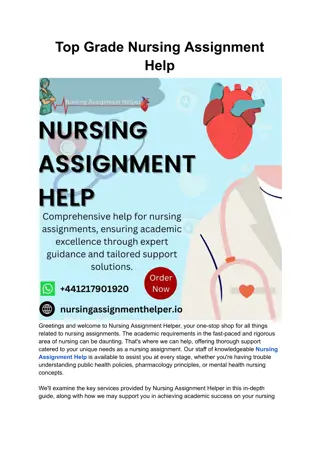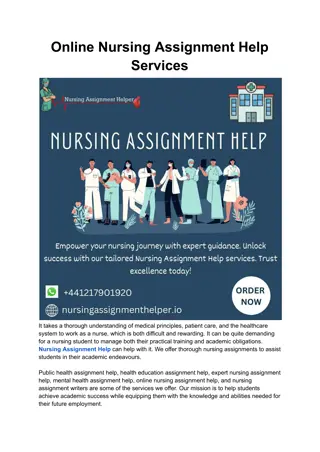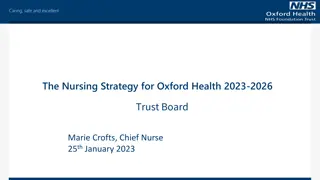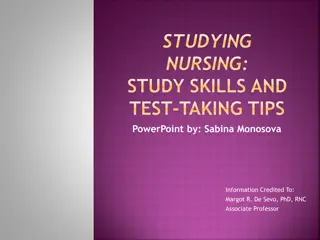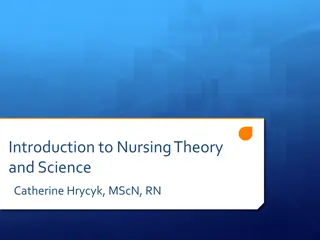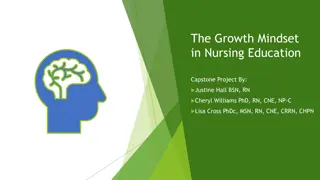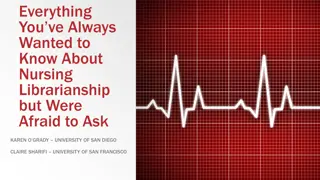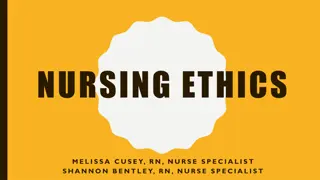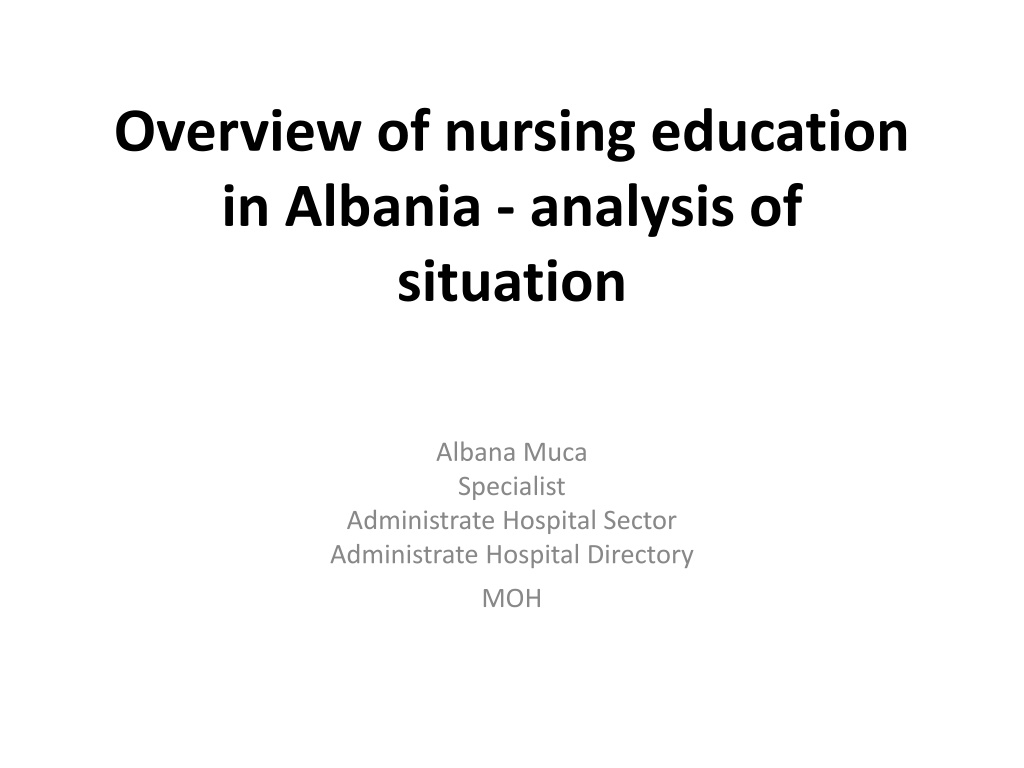
Nursing Education in Albania: Analysis and Overview
Explore the state of nursing education in Albania, where the public health system is predominant, with the Ministry of Health leading policy formulation. Nurses play a vital role in delivering healthcare services, particularly in primary health care. The sector of nursing was established in May 1999 to enhance standards and provide adequate training for nursing professionals.
Download Presentation

Please find below an Image/Link to download the presentation.
The content on the website is provided AS IS for your information and personal use only. It may not be sold, licensed, or shared on other websites without obtaining consent from the author. If you encounter any issues during the download, it is possible that the publisher has removed the file from their server.
You are allowed to download the files provided on this website for personal or commercial use, subject to the condition that they are used lawfully. All files are the property of their respective owners.
The content on the website is provided AS IS for your information and personal use only. It may not be sold, licensed, or shared on other websites without obtaining consent from the author.
E N D
Presentation Transcript
Overview of nursing education in Albania - analysis of situation Albana Muca Specialist Administrate Hospital Sector Administrate Hospital Directory MOH
Albania Albania is a country in Southeastern Europe. Albania The health system in Albania is mainly public. The state provides the most of services offered to the population as in the field of promotion, prevention, diagnosis and treatment. The private sector is still in its infancy and covers the largest pharmaceutical services, dental services and some specialty diagnostic clinics, hospital which are mainly concentrated in Tirana.
Health System MOH plays the leader role in public sector which is responsible for drafting and policies and strategies of the health system, its the coordination of all stakeholders inside and outside the system. Diagnostic and curative health service is organized into three levels: primary service, hospital service secondary, and tertiary hospital. Public health services and promotion offered under the primary health care and supervised and supported by Institute of Public Health (IPH).
Nurses in the Health Sector Public Health Sector : Total number of Hospital is 44.( District hospital, Municipality hospital, University hospital) Health Center 421 Health Center in PHC Total number of nurses (2012) is 12847, of which 6660 (IHCI ) nurses work in PHC (Primary Health Care), and 6187 work in secondary healthcare (hospitals). Nurses and midwifes represent the largest category of workforce in our system. The impact and contribution of this category is of vital importance in delivery of health care services, especially at the primary health care.
GENERAL OVERVIEW Sector of Nursing is create in MOH, May, 1999 Human Resources Dep; AHD The goals are:- to provide a new policies for nursing, -reviews and updates standard nursing protocols; - national guidelines; - improving the quality of service, quality of care in hospital and Primary Health Care; -adequate education and training to exercise nursing functions. Recognize the vital role of nursing personnel and other health workers for the health and wellbeing of populations. The classification of nurses is based on three important factors: The significant large number of nurses which is the biggest category of health professionals in Albania. The noticeable differences in nurses basic education during the last three decades. The reform-based changes in our health and education system that have influenced directly the formation and job description for this category.
Nurses in the Health Sector YEARS 1996 2000 2009 PHYSICIANS 4,278 4,325 3,655 NURSES 14,284 12,570 12, 455 NURSE/PHYSICIAN 3.34 2.91 3.4 -The nurses/physicians ratio in Albania is one of the highest in the region (average ratio 2.5). -Based on the reforms on health system financing, most nurses are paid by the IHCI, and only a small percentage continue to get paid from the MOH. -The number of nurses for 10.000 habitants is 14.1 (2011). -About 90% (nurses, midwives, physicians) are female in public health sector.
Health Sector/ Education of nurses Nurses based on their professional education during 3 decades: -Nurses with a bachelor degree (1) - Nurses with High School Degree (2) - Nurses with 1-2 year degree, post-high school (medical school, or general school) (3) -Nurse with 2-3 years , post school 7-8 years(4)( don t have ) -Nurses/Assistants who have attended specialized nursing courses, following high school (5) In Public Health Sector during 2006nurses with bachelor degree was 7%, and 2011 are 85% with bachelor degree without mentioning other nurses which are continuing . Other nurse (2, 3, 5) are continue the university level for nurses in part time in public; or private faculty of Nurses.
Education of Nurses Since the movement of the mid-90s, Nursing Education in Albania has seen many challenges, especially in university- based programs for initial education (pre- service) practitioners. Are amended all undergraduate programs in line with the recommendation has the Bologna process, so that degrees "Bachelor" already provided with successful completion of three academic years, each of 60 ECTS. Another influence in nursing education are private universities that offer programs for initial education of nursing students. In the faculty of Nurses we have new professional profiles such as speech therapists, physical therapists, laboratory technicians, etc. Since 1994 created Higher School of Nursing In Tirana, Kor a,, Vlora, and late in Gjirokaster, Shkoder and Elbasan. Higher school are covered by Ministry of Education And Science. Have integrated nurse- teacher in teaching staff, and faculty of Nursing continue to be directed by doctors. Nursing schools are using new methods of teaching.
Higher education institutions that offer nursing degrees (2010, Ministry of Education) Public Institucionals Nursing and its related fields University of Tirana- School of Nursing General nursing ; Nursing/Midwifery Physiotherapy ; Medical Imaging Speech Therapy ; Laboratory technician Branch in Kuk s, Branch in Saranda -2011 Aleksand r Xhuvani University - Elbasan General nursing ; Nursing/Midwifery Fan. S. Noli University Kor General nursing ; Nursing/Midwifery Luigj Gurakuqi University Shkod r General nursing ; Nursing/Midwifery Physiotherapy Eq rem abej University- Gjirokast r General nursing Aleksand r Moisiu University Durr s Branch in Peshkopi General nursing Ismail Qemali University Vlor General nursing Nursing/Midwifery
Higher education institutions that offer nursing degrees (MES,2010) Private Institutions Nursing and its related fields Medikadent University General nursing Our lady of Good Counsel University (UZKM) - Branch in Elbasan General nursing ; Physiotherapy Kristal University General nursing; Laboratory American University of Tirana (UAT) General nursing ; Physiotherapy Laboratory Technician ; Medical Imaging Aldent University General nursing Queen Geraldine University General nursing Planetary University of Tirana General nursing
Education of Nurses/ Hours/ Accreditation/ Enrollment The first level degree in General nursing is 3 academic years, which is translated into 4500-5500 academic hours, including the hours in class, self- study and the professional practice. Based on the General Nursing programs of 11 accredited universities (7 public and 4 private (2010). The total number of the modules that are taught in these programs is 56, of which 18 (32%) are the same in all programs. More than half of the students (60%) enrolled in public nursing schools belong to the University of Tirana . Hours distribution University University Public Private Total Academic Hours Classroom hours & Tiran (Public) 4500 2172 Vlor (Public) 4500 1800-2250 Shkod r (Public) 4500 2014 UZKM (Privet) 5355 1820 Kristal (Privet) 5509 2142 UAT (privet) 4470 2580
Number of graduates with a nursing degree from Public Universities ( INSTAT) University 1998 2002 2006 2010 -The number of graduates in 2010 is five times higher than the number of graduates in 1998 and the trend of this increase. -About 94% of the nursing graduates obtained General nursing diplomas, -6% obtained diplomas in Nursing/Midwifery, Physiotherapy, Medical Imaging etc. -After General nursing, the most preferred field is Laboratory Technician, and Speech therapy. University Tirana University Elbasan (2002) University Shkodra (2003) University Gjirokastra (1999) University Kor a University Vlora of 108 70 173 218 153 of 156 of 188 90 of 88 30 66 of 128 54 112 90 of 339 44 132 96 1144 Total 168 382 671
Education of Nurses/ First & master degrees Master s degrees is 1+ 2 = 60ECTS Doctor is for 3 years. The academic formation of nurses consists in 6 first level diplomas and 7 master s diploma, one of which is a scientific master. The first level degrees The master s degrees General Nursing Health management Nursing/Midwifery Nursing/Midwifery Physiotherapy Physiotherapy *Nursing surgery, Nursing surgery and the Scientific master in nursing sciences are still unaccredited and are offered by the Ismail Qemali University Vlor .) Medical Imaging Laboratory Technician Speech Therapy Nursing surgery* Laboratory Technician Nursing surgery* Scientific master is nursing sciences*
Health and education system reforms; their impact on nursing job market Bologna system, (2003 process in 1999) Law on Higher Education (2010), Law for the Nursing Order (2007) -The Statute and the Ethical Deontological Code of Nurses, Midwives and Physiotherapists, (2008). Change in procedures in licensing. Ministry of Education and Science compiled the Law on Regulated Professions( 2010), which: - All nurses, midwives, and physiotherapists , laboratory technician graduated after May 2010, in order to gain the right to exercise their profession should pass a state exam.
Continuing professional development Until 2010 Nurses was not involved in first phase of the recertification program due to the following difficulties: The great number of professionals in this category The lack of a detailed database of all nurses registered in the health sector The differences in basic education of this category. The lack of continuing education activities offered for this category. - National Center for Continuing Education ( create in 2008) with collaboration MOH, Nursing Order, & Zvicer Cooperation start piloting (for three years 2011-2014) the implementation of the recertification process for a small number of nurses (489).







